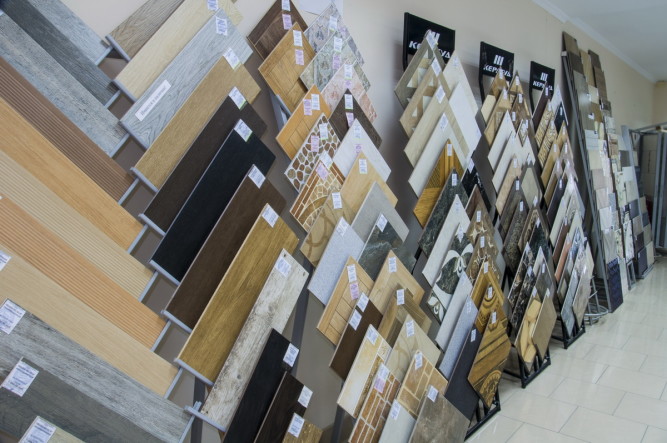How to put tiles on the floor in the bathroom with your own hands
Every homeowner is faced with the problem of laying tiles on the floor in the bathroom. It is not so difficult to do it with your own hands, if you follow the rules and recommendations. We will divide the process into separate stages and consider them in detail.
Follow the recommendations when laying floor tiles
Necessary tools and materials
Let's start with a list of what you need to work.
- floor tiles;
- adhesive solution;
- set of spatulas, including gear and rubber;
- grout for seams;
- primer;
- antifungal impregnation;
- wide brushes;
- self-leveling floor mixture;
- perforator;
- chisel;
- level;
- mallet;
- pencil;
- ruler;
- plastic crosses;
- master;
- hollow roller;
- tile cutter;
- Bulgarian;
- sponge;
- respirator;
- construction glasses.
A set of tools is required
Since we will lay the tiles on the floor in the bathroom, where moisture and moisture accumulation are normal, do not forget about waterproofing impregnation.
Surface preparation
Before you start laying tiles on the floor in the bathroom, prepare.
- Dismantling of the old coating. Use a hammer and chisel to remove the tile. The work is vigilant, so take care to protect your eyes and respiratory tract. To make it easier to remove the tile, pre-clean the joints with a scraper. It is recommended to remove the remains of the solution with a Bulgarian.
- Waterproofing. Provide reliable protection against the passage of moisture into the concrete.
- Leveling. That the tile did not crack and kept well in place, qualitatively level the floor. Often the ideal option is to pour a self-leveling mixture, which is easy to make with your own hands. Of course, a layer of screed will take a few inches high, but such a surface is ideal for laying tiles. If you plan to install a heating system under the tile, take into account, that it is mounted on the floor.
- Antifungal impregnation. Finish the floor, do not miss a single centimeter, it is even better to miss the concrete several times.
- Primer. This is the last layer of processing, thanks to it the tile will be better kept, and less moisture will get into the structure of the screed.
The concrete base must be leveled, eliminating defects
Waterproofing
From all preparatory works it is necessary to consider separately process of protection against hit of a moisture under a tile before laying of a tile on the leveled surface of a bathtub.. Various materials are used as a reliable waterproofing, are the most widely used:
- film flooring;
- epoxy resin;
- bituminous mastic;
- special liquid waterproofing mixture;
- water-repellent impregnation;
- oil paint.
The specifics of the room oblige to make a layer, which protects against moisture
It is safer to use special purpose tools, but more accessible materials are enough for the minimum effect. Apply liquid mixtures with a brush, it is desirable to cover in several layers. Trim and walls to a height of 10 to 40 div.
Marking
Once the surface is completely ready for tiling, start lining the coating. To mark a smooth perimeter, at the corners of the room fix the beacons and pull the thread. Then resolve the issue, how best to lay the tiles on the floor in the bathroom. Because rooms of this kind are often small in area, you need to maximize it visually. Don't buy tiles that are too big or too small, in most cases, medium-sized squares are ideal. Try to beat the floor with rectangular tiles, especially if you need to pull out one of the walls. This effect is possible by stacking rectangles with the long side parallel to the surface, which needs to be increased.
The best option is diagonal orientation, however, it may be difficult for a beginner to do it on their own.
To choose the appropriate layout, place the tile on the floor without mortar and estimate the available options. Stopping at one of them, mark the position of several tiles in different rows, they will be control. To avoid straying, draw a straight line, which marks its boundaries.
Stacking
When the markup is completely ready, proceed directly to the tile sticker itself. Dilute a small amount of adhesive mixture. Do not make too much solution, since it dries quickly and loses its properties.
How to glue ceramic tiles to the floor in the bathroom:
- Start working from the corner, which is most in sight. On the side, not covered with furniture or plumbing, stack only the whole material.
- Apply the solution needed for two or three pieces. Level the glue with a notched trowel.
- Apply the tile and press. Pay attention to that, that the reverse side must be perfectly clean, without dust and greasy stains. It is recommended to pre-soak it in water to improve the adhesive properties.
- Tap the fragment with a mallet, correct its position. To prevent damage to the tile surface, place a soft cloth over it.
- Arrange plastic crosses on the seams, so that the distance between the tiles was the same.
When sticking tiles, pay special attention to the direction of the drawing
Stacking is done in rows. First, the whole parts are glued, and then dorezayutsya fragments with a tile cutter or Bulgarian. If the glue came out, immediately remove it with a damp cloth, without waiting for it to harden. Constantly monitor the floor level. Start walking in the bathroom on a new floor no earlier than a day, or even in two.
Grouting seams
Upon completion of laying and drying the floor is sufficient for that, so that it could be stepped on, move on to further work. The last stage is grouting. That water did not get into cracks on joints of a tile, no dirt and no fungus on the floor, cover them with a special putty.
It is best to use an epoxy mixture. As a last resort, fill the joints with the remnants of sand-cement mortar.
The final manipulation when laying tiles - grout joints
Dilute a small amount of the mixture. Using a rubber spatula, apply the mass to the seam, having previously removed plastic crosses from it. Compact the grout, and remove the excess. Walk across the entire bathroom area. Once the seams are dry, start cleaning the coating. To do this, take a foam sponge and wipe the tile with water, washing away the remains of the grout. Now the main task is to keep the coating clean and tidy throughout its life.



